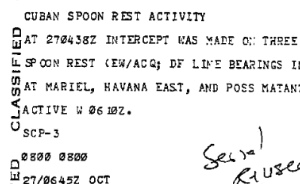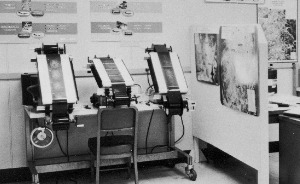talking history | syllabi | students | teachers | puzzle | about us
"Cuban Missile Crisis," National Security Agency/Central Security Service
http://www.nsa.gov/public_info/declass/cuban_missile_crisis/
Created and maintained by the National Security Agency, Department of Homeland Security.
Reviewed June–Oct. 2010.
http://www.gwu.edu/∼nsarchiv/nsa/cuba_mis_cri/
Created and maintained by George Washington University, Washington, D.C.
Reviewed June–Oct. 2010.
Interest in the epic confrontation known in the United States as the Cuban missile crisis has resulted in scores of articles, books, documentaries, and academic and political panel discussions. Scholars and politicians have asked a wide variety of questions about the crisis over the past forty-eight years regarding Cold War issues, conflict resolution, and the roles of many notorious and minor actors in the drama. Both of the archival Web sites reviewed here have gathered and provided public access to primary sources that might otherwise be unavailable to many researchers, students, and teachers.

“27 October, SPOON REST radars identified at three sites”
National Security Agency/Central Security Service
Since each archival site emphasizes declassified documents, each must be approached with an understanding of the “missions” of the creators/designers and with an appreciation of how those missions shape the selection of archival materials. The National Security Agency/Central Security Service (NSA/CSS) home page, with animated graphics and a red, white, and blue motif, provides banner links to its mission statement:
To protect U.S. national security systems and to produce foreign signals intelligence information, to collect, process, analyze, produce, and disseminate signals intelligence information and data for foreign intelligence and intellectual purposes to support national and departmental missions, and to act as National Manager for National Security Systems as established in law and policy.
Part of the NSA/CSS strategic plan is to “dominate global cryptology, secure national security systems, connect people, sensors, systems, and information on a global scale, and leverage our unique relationship with government, industry, academia, and foreign partners.”
As part of that plan, the NSA/CSS offers summer training programs for teachers, student internships, scholarships, and other K–12 and university student projects. It also sponsors conferences on topics related to security issues. Since 2003, the NSA/CSS has designated October as Cybersecurity Awareness Month. In 2010 it introduced CryptoKids, cartoon characters with whom youngsters can play games on the World Wide Web, make their own secret codes, and presumably develop an early interest in signals intelligence (SIGINT) and information gathering.
Because the NSA/CSS site emphasizes cryptology and cryptologic history, many of the documents related to the Cuban missile crisis focus on SIGINT and the role intelligence gathering played in providing information to the Central Intelligence Agency, the Department of Defense, and the executive branch before, during, and after the crisis. Included in the list of documents are dispatches, SIGINT reports under code names such as “Operation Secret Sabre” and “Operation Secret Kimbo,” and other intelligence reports gathered by the USS Oxford off the coast of Cuba and by other means (seldom disclosed). There are no documents from Cuba, the Soviet Union, or other foreign sources, nor are there links to other primary or secondary sources of information or discussion by political actors or historians about the missile crisis.
While the home page and links are uncluttered, the link descriptions are not completely revealing, wasting some of the effort of the researcher who might be investigating a specific detail. In addition, care must be taken to access information about the missile crisis through the NSA/CSS site. Choosing the search term “Cuban missile crisis” will yield about 150 links, some of which contain further links to other specific items. There is, for example, a chronological list of documents covering only the years 1960 (one memo), 1961 (seven documents), 1962 (more than fifty documents), 1963 (seven documents), 1969 (one document), and three undated documents. Using the search term “The Cuban missile crisis microfiche set” will yield what claims to be a list of 22,181 documents, though fewer than 200 of these directly bear on the Cuban missile crisis; others very briefly reference the event in interviews with retired cryptologists, addresses, or secondary articles (most of which have no citations). There is no indication provided about file size, so downloading is sometimes problematic.
Any intelligence-gathering agency places concerns for its interpretation of “national security interests” above public disclosure, and the small number of NSA/CSS documents that have been declassified for their site clearly reflects that limitation. This shortcoming is also apparent in the amount of redacted material. In addition, there are few attempts to contextualize the missile crisis in terms of global, regional, or U.S.-Cuban relations. The site does not link to external sources of analysis, providing mainly secondary sources written for and by the Center for Cryptologic History.
By contrast, the National Security Archive (NSArchive) maintained at George Washington University appears dedicated to challenging governments’ interpretations of “national security interests.” From its home page, users can link to Freedom of Information Advocates, an NSArchive project to provide more information on issues of access to government information on a global basis. Another link is to the Parallel History Project on Cooperative Security, based in Switzerland, which is investigating the past and present security dimensions of the Cold War (and contains some eastern bloc materials of relevance to the missile crisis, especially in regard to the North Atlantic Treaty Organization and the Warsaw Pact). Yet another link directs users to the Cold War International History Project through the Woodrow Wilson International Center for Scholars.

“Inside the CIA’s National Photographic Interpretation Center (NPIC), Washington D.C., 1962”
National Security Archive
The NSArchive was founded in 1985 to “check” the resurgence of Cold War government secrecy. Its mission is to declassify congressional reports, presidential papers, court testimonies, and other classified materials through consistent applications to the government under the Freedom of Information Act (FOIA). Directed by Peter Kornbluh, the NSArchive finances itself through donations, grants, and revenues from publications, including access to the digital archive collection. The NSArchive has received awards for its successful efforts to get valuable secret documents declassified and posted on the Web, making them accessible to scholars studying a wide variety of foreign and domestic policies. Data on current FOIA requests are updated, and other links address problems of access on subjects as varied as U.S. torture policies and experiences, U.S. involvement in Central American wars and other Latin American and Caribbean operations, wars in the Middle East, and disarmament. The NSArchive home page banner is black and white, and the page contains many historic pictures and links, including links to PBS documentaries, Twitter, and Facebook. Its other public service initiatives are internships, conferences and symposia, and a special annual Rosemary Award for the “worst open government performance.” Additional links explain the classification process and overclassification tendencies by the government, exemplified by multiple versions of the same documents excised/redacted over time.
Relevant documents on the missile crisis available through this site number in the tens of thousands and are accessibly cross-referenced either through the digital archive collection or through the main Cuban missile crisis link on the home page. Every effort seems to have been made to give the crisis historical context, with links to documents about the Bay of Pigs invasion, Operation Mongoose, and other covert efforts to destabilize Cuba, as well as other U.S. interventionist initiatives before and after the crisis. Documents are translated into English where necessary and include embassy cable traffic, internal briefing papers, closed hearing testimony, situation reports, transcripts of meetings, secret letters, minutes, internal histories, confidential memos, oral histories, press backgrounds, and briefings. In addition, presidential directives on national security and Cold War strategies from Harry S. Truman to Bill Clinton are part of other large and related microfiche sets.
Chronologies, audio clips, photographs, and analysis by prominent U.S. scholars exploring the complex issues of the Cuban missile crisis are also included in the collection. The editorial board of the missile crisis section recognizes, however, that putting together a comprehensive and balanced record of the crisis still requires declassifying and incorporating more Cuban and Soviet documents than have been available so far. They continue to pursue those opportunities and to gather material from other parts of the globe.
An important consideration for using the NSArchives is accessibility. While an impressive number of documents are easily accessed online from the home page, and are well indexed and tagged, the largest part of the Cuban missile crisis collection is available only through the digital archive. There, the ease of navigation and usefulness to researchers is more evident. Scholars can search by chronology, glossary/keyword, specific documents, or document types. In addition, researchers can save citations within the archive for later reference. However, the digital collection—including trial use—is only available through libraries via ProQuest, not to the general public. If your institution does not pay to subscribe, this will not be accessible to you. No information is provided on file sizes, but all downloads are generally speedy and reliable.
Both sites can be valuable to researchers who study the Cuban missile crisis, providing insights on many dimensions of policy and politics, but the NSArchive contains a larger, more varied, and more contextualized set of materials.
Susan J. Fernandez
University of South Florida
St. Petersburg, Florida
